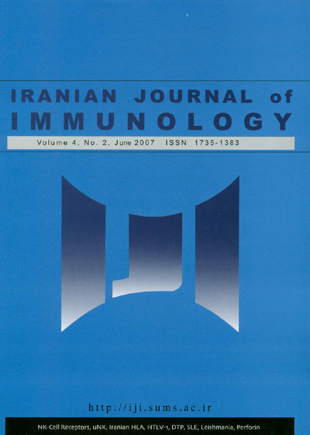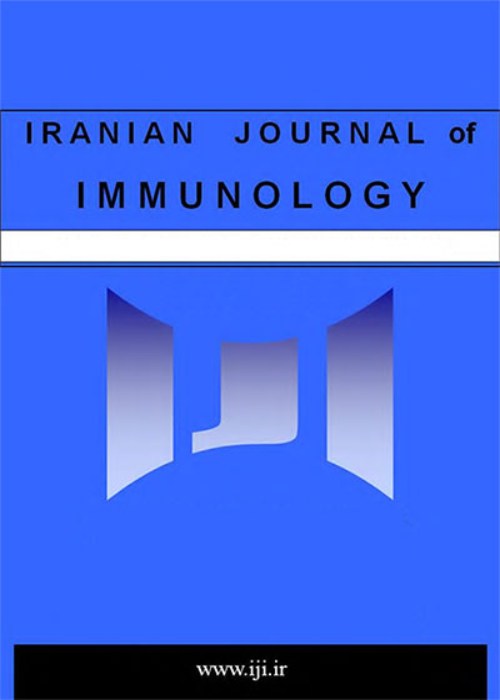فهرست مطالب

Iranian journal of immunology
Volume:4 Issue: 2, Spring 2007
- 70 صفحه،
- تاریخ انتشار: 1386/05/07
- تعداد عناوین: 8
-
-
Pages 61-78Natural killer (NK) cells are a subset of lymphocytes which play a crucial role in earlyinnate immune response against infection and tumor transformation. Furthermore,they secrete interferon-g (IFN-g) and tumor necrosis factor (TNF) prompting adaptiveimmunity. NK cells distinguish the unhealthy cells from the healthy ones through anarray of cell-surface receptors. Human NK cells use inhibitory and activating killercell Ig-like receptors (KIR) as primary probe to discriminate between healthy andunhealthy cells. The inhibitory KIRs recognize HLA class I molecules and triggersignals that stop NK killing. The activating KIRs are believed to recognize thedeterminants associated with infections and tumors, and trigger signals that activateNK killing. Therefore, the effector function of a given NK cell depends upon thereceptors that it expresses and ligands that it recognizes on the targets. Genesencoding KIRs and HLA ligands are located on different chromosomes, and vary innumber and type. The independent segregation of KIR and HLA genes results in variable KIR-HLAcombinations in individuals, which may determine the individual’s immunity and susceptibility to disease.
-
Pages 79-84BackgroundUterine natural killer (uNK) cells are the most abundant leukocytes in preimplantation endometrium and early pregnancy deciduas in humans and rodents. They are associated with structural changes in maternal spiral arteries but regulation of their recruitment and activation is incompletely understood. The major subpopulation ofuNK cells in humans expresses CD56, the neural cell adhesion molecule (NCAM)-1 while their counterparts in mouse express asialoGM1, a brain ganglioside. Sympathetic nerves express NCAM-1 which mediates homotypic binding. Sympathetic fibers innervate the mesometrial vasculature but their relationship to the myometrial and decidual uNK cell recruitment is unknown.ObjectiveThe present study aimed to explore positional relationship between natural killer cells and distribution of nerves in decidualized mouse uterus.MethodsImmunohistochemistry and mRNA expression forthe enzyme tyrosine hydroxylase were used to map sympathetic nerve fibre distributionwithin C57BL/6 implantation sites and to address a relationship with uNK cells.ResultsTyrosine hydroxylase positive neurons were identified in the mesometrium closely associated with uterine arteries. Staining became gradually vanished as the nerves crossed the myometrium and entered the decidualized uterus. No neuronal stain was associated with the spiral arteries. Periodic Acid Schiff’s reactive uNK cells were absent from the mesentery, but abundant in decidua basalis where they are associated with non-innervated vessels.ConclusionData suggest that the recruitment of uNK progenitor cells to the uterus is unlikely to be dependent on signaling by the sympathetic nervous system
-
Pages 85-93BackgroundAnthropological studies based on highly polymorphic HLA genes provide useful information for bone marrow donor registry, forensic medicine, disease association studies, as well as designing peptide vaccines against tumors, and infectious or autoimmune diseases.ObjectiveThis study was designed to investigate the genetic relationship of Iranian Arabs and Jews using HLA-class II genetic diversityMethodsHLA-DRB1, DQA1, and DQB1 allele frequencies and haplotypes were determined in 134 Iranian Arabs from two different communities and 91 Iranian Jews using PCR/RFLP and PCR/SSP methods.ResultsNeighbor-joining analyses showed a closer genetic relationship between Iranian Arabs and Iranian Jews than between either Iranian Arabs and Middle Eastern Arabs or Iranian Jews and other Jews. The results of AMOVA test also revealed no significant difference between these populations and other Iranians.ConclusionIt seems that, Iranian Arabs are originally from the Iranian gene pool and speak Arabic due to their encounter with Arabs. Iranian gene flow to immigrant Jews followed by their expansion in this country may also explain the close genetic relationship among different Iranian ethnic groups.
-
Pages 94-100BackgroundHuman T cell lymphotropic virus type I (HTLV-I)-associated myelopathy/tropical spastic paraparesis (HAM/TSP) is an inflammatory disease which occurs in less than 2% of HTLV-I -infected individuals. High proviral load, high HTLV-I-specific CD8+ cytotoxic T lymphocyte frequency (CTL) and host genetic factors such as HLA all appear to be associated with HTLV-I infection. Previous studies have shown that HLA-DRB1*01 increases the risk of HAM/TSP in Japanese HTLV-I infected individuals.ObjectiveTo investigates the association between HLA class II DRB1 alleles and HLA class I alleles (HLA-Cw*08, B54, A*02 and A-30) in HTLV-I infected individuals in Mashhad.MethodsHere we determined the frequency of HLA class II DRB1, using INNO-LIPA reverse hybridization line probe assay, and HLA class I alleles (HLA-Cw*08,B54, A*02 and A-30) by PCR-SSCP method in healthy controls, HAM/TSP patients and HTLV-I infected individuals born and resident in Mashhad.ResultsThe frequency of HLA-DRB1*01 alleles in this population was different from other areas of Iran. The frequency of HLA-DRB1*01 was significantly increased in HAM/TSP patients compared with carriers (p 0.028; OR=9.4). The frequency of HLACw*08 was also significantly increased in HAM/TSP patients compared with controls (p=0.03; OR=13.5).ConclusionOur results may suggest that possession of HLADRB1* 01 increases the risk of HAM/TSP in HTLV-I-infected individuals and HLACw* 08 correlates with low CTL immune response in HAM/TSP patients.
-
Pages 101-109BackgroundImmunization against diphtheria, tetanus and pertussis has been applied in Iran since 1950. WHO suggests periodical evaluation of effectiveness of the triple diphtheria-tetanus-whole cell pertussis (DTwP) vaccine, worldwide.Objective(s)To determine the immunogenicity of locally manufactured DTwP vaccine administered to preschool children in a number of health centers of Tehran in 2006.Method(s)In this prospective study, 350 children aged 4-6 years were injected with DTwP vaccine manufactured by Razi Institute of Iran. Blood samples were collected before and 2-4 weeks after the vaccination. The immunogenicity of the vaccine was assayed by measurement of specific antibodies using enzyme-linked immunosorbent assay (ELISA) technique.ResultsOf the 337 children who were vaccinated, 99.4% and100% had protective anti-diphtheria and anti-tetanus antibody titers, respectively. Thevaccine response and seroconversion for pertussis was achieved in 70.3% of the subjects. The geometric mean titers (GMT) of the antibodies produced against diphtheria, tetanus and pertussis by DTwP vaccine were 7.76, 9.37 IU/ml and 30.20 EU/ml after booster vaccine dose, respectively.Conclusion(s)Comparison of the results obtained from this study with those of previous work performed in other countries reveals that immunogenicity of diphtheria and tetanus components is similar to other vaccines, but the immunogenicity of pertussis vaccine was less efficient. The lower immunogenicity of DTwP against pertussis may be related to the bacterial strain used or the formulation protocol adopted for the vaccine preparation
-
Pages 110-115BackgroundSystemic Lupus Eyrythematosus (SLE) is an autoimmune disease characterized by antibodies to nuclear antigens, particularly anti-dsDNA. Imbalance between production and destruction of immune cells causes cytopenia. Sex hormones have immunomodulatory effects; estrogen increases the production of autoantibodies in SLE prone NZB/NZW mice.ObjectiveTo investigate the relationship between sex hormones, anti-dsDNA, and lymphocyte subsets in Iranian patients with SLE.Methods38 SLE patients (28 females and 10 males) meeting 4 of 11 ACR revised criteria for SLE classification, and 20 age and sex matched healthy individuals (10 females and 10 males) participated in this study. Lymphocyte subsets were analyzed using flow cytometric analysis. Serum anti-dsDNA levels and sex hormones concentrations were determined using commercial ELISA and RIA kits, respectively.ResultsThe absolute count of white blood cells, lymphocytes, T lymphocytes(CD3+), T helper cells (CD3+CD4+), B cells (CD19+) and Nk cells (CD3- CD16+CD56+) in SLE patients diminished significantly in comparison to control group (p<0.05). IgG anti-dsDNA antibody levels were significantly higher in patients compared to controls as expected (p<0.05). Prolactin increased significantly, while DHEAS showed a significant decrease in SLE patients compared with the controls (p<0.05), however the level of estrogen did not have any significant difference in SLE patients in comparison to controls.ConclusionIncreased concentration of prolactin together with a simultaneous decrease in serum DHEAS in SLE patients are associated with anti-dsDNA elevation and a decrease in almost all lymphocyte subsets.
-
Pages 116-121BackgroundThe causative agent of VL in Iran is L.infantum (Mediterranean type) and its major reservoir host is dog.ObjectiveTo compare the serological methods including direct agglutination test (DAT), indirect immunofluorescent-antibody test (IFA) and enzyme-linked immunosorbent assay (ELISA) for serodiagnosis of endemic strain of Leishmania infantum.Methods61 blood samples from VL patients referred to Shiraz hospitals and 49 blood samples from control group were collected. Native strain of the parasite isolated from a VL patient from the region was cultured and characterized. Antigens from this L. infantum parasite were used in ELISA and IFA system.ResultsAnti-Leishmania antibody was detected in 43 (70.5%), 49 (80.3%) and 51(83.6%) cases using DAT, IFA and ELISA, respectively. Based on these results, sensitivity and specificity of DAT was found to be 70.5% and 100%, respectively. Sensitivity of IFA and ELISA in diagnosis of VL was 80.3% and 83.6% and their specificity was 90.5%.ConclusionResults of this study showed that DAT and ELISA have the highest specificity and sensitivity in diagnosis of VL. DAT is a simple, cost-effective and field applicable test. Thus, it can be recommended for early and accurate diagnosis of VL, especially in regions where malaria, brucellosis and tuberculosis are prevalent.


